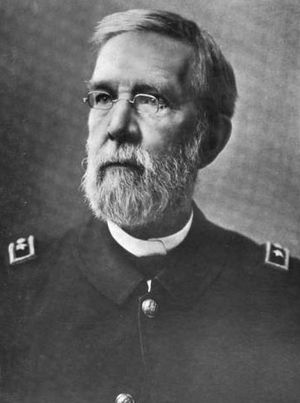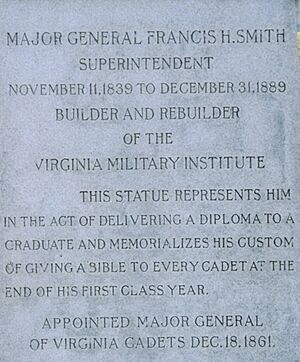Francis Henney Smith facts for kids
Quick facts for kids
Francis Henney Smith
|
|
|---|---|

Francis Henney Smith, first Superintendent of Virginia Military Institute.
|
|
| Born | October 18, 1812 Norfolk, Virginia |
| Died | March 21, 1890 (aged 77) Lexington, Virginia |
| Buried |
Oak Grove Cemetery
Lexington, Virginia |
| Allegiance | |
| Service/ |
|
| Years of service | 1833–1836 (USA) 1861–1865 (CSA) |
| Rank | Major General (VA Militia) |
| Unit | 1st U.S. Artillery |
| Commands held | 9th Virginia Infantry Virginia Military Institute |
| Battles/wars | American Civil War |
| Other work | Superintendent of the Virginia Military Institute |
Francis Henney Smith (born October 18, 1812 – died March 21, 1890) was an American military officer, a skilled mathematician, and a dedicated educator. After finishing his studies at West Point, he served briefly in the United States Army. In 1839, he became the very first Superintendent of the Virginia Military Institute (VMI) when it was founded. He held this important job for many years, almost until he passed away. His time as Superintendent included the four years of the American Civil War. During the war, he served as a major general in the Virginia militia and a colonel in the Confederate States Army.
Contents
Early Life and Education
Francis Henney Smith was born in Norfolk, Virginia. He married Sarah Henderson on June 9, 1835, while he was at West Point, New York. They had seven children together.
Smith graduated from the United States Military Academy in 1833. He served as a second lieutenant in the United States Army until 1836. After leaving the army, he taught mathematics at Hampden–Sydney College from 1836 to 1839.
When the Virginia Military Institute (VMI) was being set up in Lexington, a board member named John Thomas Lewis Preston asked Smith to be the school's first superintendent. Classes at VMI began on November 11, 1839. Preston also joined the faculty and worked with Smith at VMI until he retired in 1882.
Before the Civil War began, Smith was made a colonel in the Virginia Militia. He also wrote books on math and education, including An Elementary Treatise on Algebra. He is also known as the spiritual founder of the Sigma Nu International Fraternity.
Role in the Civil War
When the Civil War started, Smith was appointed a Brigadier General in the Virginia Militia in April 1861. He then became a colonel in the 9th Virginia Infantry Regiment in July 1861. However, he often returned to VMI, especially when it reopened in late 1861. He was later appointed a major general in the Virginia Militia, and was known as "Major General of Cadets" at VMI.
During a key part of the 1864 campaign in the Shenandoah Valley, Major General John C. Breckinridge was in charge of Confederate forces. He didn't want to use the VMI cadets in battle. But when Union forces moved into the valley, Breckinridge asked Smith to send the cadets to help his army, which was outnumbered.
On May 12, 1864, Smith sent almost all of the VMI Corps of Cadets to help. Only 27 cadets stayed behind to guard the Institute. Smith himself was ill and also stayed behind. The cadets were led by 24-year-old Scott Shipp, who was the Commandant of Cadets and a VMI teacher.
Battle of New Market
On May 15, 1864, the VMI Cadets became famous at the Battle of New Market. They are the only group of cadets in United States history to fight as a unit in a battle. Ten cadets were killed and forty-seven were wounded while defending the center of the Confederate line. The Union forces were defeated and had to retreat.
After the battle, on June 11, 1864, Union Major General David Hunter ordered an attack on VMI. His troops burned and shelled the campus. This forced classes to move to Richmond, where they stayed until the city fell in April 1865. Classes returned to the Lexington campus in October, after the war ended.
Later Life and Legacy
After the war, Francis Henney Smith was in charge of rebuilding VMI, which had been badly damaged. He continued to serve as superintendent until December 31, 1889.
He passed away in Lexington on March 21, 1890, at 77 years old. He is buried in Oak Grove Cemetery. His letters and other writings are kept at VMI, helping us learn more about his life and work.
See also


